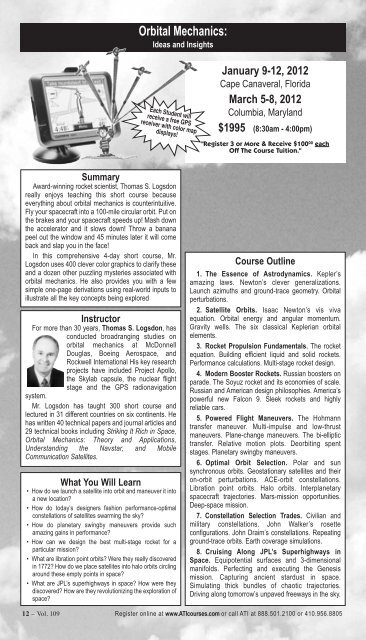Acoustics & Sonar Engineering Radar, Missiles & Defense Systems ...
Acoustics & Sonar Engineering Radar, Missiles & Defense Systems ...
Acoustics & Sonar Engineering Radar, Missiles & Defense Systems ...
You also want an ePaper? Increase the reach of your titles
YUMPU automatically turns print PDFs into web optimized ePapers that Google loves.
Instructor<br />
For more than 30 years, Thomas S. Logsdon, has<br />
conducted broadranging studies on<br />
orbital mechanics at McDonnell<br />
Douglas, Boeing Aerospace, and<br />
Rockwell International His key research<br />
projects have included Project Apollo,<br />
the Skylab capsule, the nuclear flight<br />
stage and the GPS radionavigation<br />
system.<br />
Mr. Logsdon has taught 300 short course and<br />
lectured in 31 different countries on six continents. He<br />
has written 40 technical papers and journal articles and<br />
29 technical books including Striking It Rich in Space,<br />
Orbital Mechanics: Theory and Applications,<br />
Understanding the Navstar, and Mobile<br />
Communication Satellites.<br />
What You Will Learn<br />
• How do we launch a satellite into orbit and maneuver it into<br />
a new location?<br />
• How do today’s designers fashion performance-optimal<br />
constellations of satellites swarming the sky?<br />
• How do planetary swingby maneuvers provide such<br />
amazing gains in performance?<br />
• How can we design the best multi-stage rocket for a<br />
particular mission?<br />
• What are libration point orbits? Were they really discovered<br />
in 1772? How do we place satellites into halo orbits circling<br />
around these empty points in space?<br />
• What are JPL’s superhighways in space? How were they<br />
discovered? How are they revolutionizing the exploration of<br />
space?<br />
Orbital Mechanics:<br />
Ideas and Insights<br />
Each Student will<br />
receive a free GPS<br />
receiver with color map<br />
displays!<br />
Summary<br />
Award-winning rocket scientist, Thomas S. Logsdon<br />
really enjoys teaching this short course because<br />
everything about orbital mechanics is counterintuitive.<br />
Fly your spacecraft into a 100-mile circular orbit. Put on<br />
the brakes and your spacecraft speeds up! Mash down<br />
the accelerator and it slows down! Throw a banana<br />
peel out the window and 45 minutes later it will come<br />
back and slap you in the face!<br />
In this comprehensive 4-day short course, Mr.<br />
Logsdon uses 400 clever color graphics to clarify these<br />
and a dozen other puzzling mysteries associated with<br />
orbital mechanics. He also provides you with a few<br />
simple one-page derivations using real-world inputs to<br />
illustrate all the key concepts being explored<br />
January 9-12, 2012<br />
Cape Canaveral, Florida<br />
March 5-8, 2012<br />
Columbia, Maryland<br />
$1995 (8:30am - 4:00pm)<br />
"Register 3 or More & Receive $100 00 each<br />
Off The Course Tuition."<br />
Course Outline<br />
1. The Essence of Astrodynamics. Kepler’s<br />
amazing laws. Newton’s clever generalizations.<br />
Launch azimuths and ground-trace geometry. Orbital<br />
perturbations.<br />
2. Satellite Orbits. Isaac Newton’s vis viva<br />
equation. Orbital energy and angular momentum.<br />
Gravity wells. The six classical Keplerian orbital<br />
elements.<br />
3. Rocket Propulsion Fundamentals. The rocket<br />
equation. Building efficient liquid and solid rockets.<br />
Performance calculations. Multi-stage rocket design.<br />
4. Modern Booster Rockets. Russian boosters on<br />
parade. The Soyuz rocket and its economies of scale.<br />
Russian and American design philosophies. America’s<br />
powerful new Falcon 9. Sleek rockets and highly<br />
reliable cars.<br />
5. Powered Flight Maneuvers. The Hohmann<br />
transfer maneuver. Multi-impulse and low-thrust<br />
maneuvers. Plane-change maneuvers. The bi-elliptic<br />
transfer. Relative motion plots. Deorbiting spent<br />
stages. Planetary swingby maneuvers.<br />
6. Optimal Orbit Selection. Polar and sun<br />
synchronous orbits. Geostationary satellites and their<br />
on-orbit perturbations. ACE-orbit constellations.<br />
Libration point orbits. Halo orbits. Interplanetary<br />
spacecraft trajectories. Mars-mission opportunities.<br />
Deep-space mission.<br />
7. Constellation Selection Trades. Civilian and<br />
military constellations. John Walker’s rosette<br />
configurations. John Draim’s constellations. Repeating<br />
ground-trace orbits. Earth coverage simulations.<br />
8. Cruising Along JPL’s Superhighways in<br />
Space. Equipotential surfaces and 3-dimensional<br />
manifolds. Perfecting and executing the Genesis<br />
mission. Capturing ancient stardust in space.<br />
Simulating thick bundles of chaotic trajectories.<br />
Driving along tomorrow’s unpaved freeways in the sky.<br />
12 – Vol. 109 Register online at www.ATIcourses.com or call ATI at 888.501.2100 or 410.956.8805

















